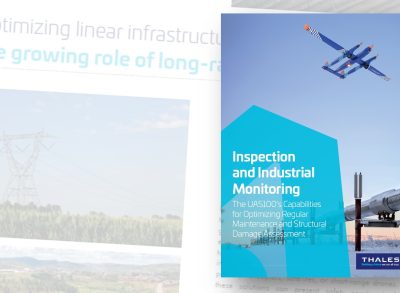Making sense of chaos - Untangling UAS regulations

In an attempt to walk the tight rope between facilitating drone operations and not putting anyone at a disadvantage in the process, the European Commission (EC) has implemented a new regulatory framework. However, as with all regulations, it can sometimes be difficult to navigate the changes. It may even be more difficult to see new opportunities (business or otherwise) in these changes. That is why Thales, leveraging decades of experience in the Air Traffic Management (ATM) domain, and having actively participated in the preparations for and review of this regulation, is the partner of choice to start implementing it – with ease of mind.
Understanding the constraints of BVLOS drone operations
It is now a widely accepted fact that, in the coming years, the number of drones operating BVLOS in non-urban and cities’ airspaces is set to increase dramatically. From businesses using these small systems for faster, more efficient deliveries or to survey infrastructure, to hospitals harnessing their benefits to move critical and time-sensitive items – such as organs, blood or medicines – drones will soon become a normal feature of our skies, just like airplanes.
Yet with every major development come significant practical and regulatory challenges. Not unlike airplanes, drones flying in urban environments inevitably means potentially flying within restricted zones, such as prisons, airport controlled zones (CTR), or government buildings. Additionally, their potential proximity to crowded areas may present ground risks to humans if a drone were to crash.
As such, flying drones BVLOS is not too dissimilar from preparing to fly a small aircraft: mission intents have to be submitted, authorisations requested and (hopefully) granted, and constant communication secured. This process is critical to ensure safety of operations – I.e., avoid collisions – and it is also significantly complex for the stakeholders involved, from operators requesting permissions to authorities granting them. Today, it can take up to six months to obtain all the permissions for a 10-minute flight. Unsurprisingly, no sensible business case can be made for that, not from a drone operator nor an Authority point of view.
To address these constraints, the EC has developed a regulatory framework for VLOS and BVLOS drone operations, comprising three separate regulations aimed at addressing these issues.
Creating a U-space for safer drone operations…
To deal with the inherent complexity – and potential safety hazard – of BVLOS drone operations, a few organisations (authorities, territories,…) have established drone operations “corridors” or Temporary Restricted Zones. These corridors are small, complex to set-up precluding any other type of operations, and are, therefore, not viable in the longer term.
EC regulation 2021/664 on a regulatory framework for the U-space addresses this issue by replacing these corridors with the creation of U-spaces. According to the regulation, the U-space is a “UAS [Unmanned Air System] geographical zone designated by Member States [MS] where UAS operations are only allowed to take place with the support of U-space services.” In other words, U-spaces are geographical zones drastically facilitating UAS operations.
Within those spaces, two automated families of digital services are constantly running to ensure safe and efficient BVLOS drone operations: the Common Information Services (CIS) and the U-Space Services (USS).
The provider of CIS, the CISP – generally designated by each MS and thus far mostly falling within the purview of ANSPs – is the system providing all the necessary data to ensure proper definition of operational U-space characteristics – i.e., single source of truth. This database includes: local requirements, such as U-space capacity, hours of operations, etc; geographical information, such as U-space geometry, restrictions, etc; ATM/ANS data, including traffic data and NOTAM; USSP directory.
The USSP is the entity responsible for providing drone operators with U-space services of which four are mandatory – Network Identification, Geo-awareness, UAS flight authorisation, and Traffic information – and two may be provided as additional services – Weather Information and Conformance Monitoring. This information is what will show on a UAS operator’s HMI. The EC allows – in fact, encourages – multiple USSPs operating within the same U-space.
The introduction of CISP and USSP is therefore meant to provide easily accessible interfaces facilitating information exchange between all U-Space actors.
… Easily accessible to everyone…
In addition to facilitating U-Space access, the EC also designed the new regulatory framework to make airspace access fairer for everyone. Indeed, today’s UAS-dedicated corridors or Temporary Restricted Zones automatically excludes manned aviation operations. Such approach is neither fair nor efficient, as both manned and unmanned are effectively restricted in their movements to specific, perhaps far from straightforward, routes and zones.
EC regulation 2021/666 amending Regulation EU 923/2012 as regards requirements for manned aviation operating in U-space airspace aims to address this issue. It stipulates that small, manned aircraft, not falling within the purview of ANSPs, must communicate their position to USSPs in order to be able to safely operate alongside UAS. This is what the regulation refers to as “e-conspicuity” and it applies to gliders, helicopters, hot air balloons, and light aviation operators and pilots.
Beyond the importance of allowing U-Space access to all light aviation systems alongside UAS, EU 2021/666 is important because it allows these systems’ operators to use affordable e-conspicuity systems such as ADS-L (Automatic Dependent Surveillance – Light). ADS-L works like ADS-B (Broadcast) but does not require certified equipment and can even be emitted by mobile phones rather than requiring the purchase of additional equipment.
As such, by making e-conspicuity mandatory and affordable, the EU enables fair, safe and efficient access to U-Spaces to multiple users.
… And easy to manage…
The last piece of the new EC regulatory framework puzzle aims to address the pains and constraints UAS operations create for ANSPs. Every time a UAS seeks to fly across an airport’s CTR, depending on the type of operation and proximity to runways, ANSPs must address the individual request by assessing all risks against all ongoing and foreseen air operations. In addition to being time-consuming, this is not scalable for a substantial volume of drone operations. And if a sudden emergency occurs – e.g., a re-routed flight requesting permission to land in an airport – communicating with all potential users of the space can be complex.
The EC designed regulation 2021/665 amending Regulation EU 2017/373 as regards requirements for providers of air traffic management/air navigation services and other air traffic management network functions in the U-Space airspace designated in controlled airspace to facilitate UAS management in ANSPs’ CTR. EU 2021/665 requires ANSPs to communicate with USSPs and CISPs – when ANSPs are not already CISPs – in order to facilitate dynamic airspace reconfiguration. This enables to ensure segregation with manned traffic where air risk is the highest by temporarily closing a portion of the U-Space.
For example, say a drone operator sees from the CISP information provided through the USSP that between the hours of 10am to 12pm a given airport CTR is open for UAS operations. After obtaining authorisation for their chosen flight path through the CTR, the UAS operator starts flying. At 11am, however, the airport’s control tower receives notification that a manned flight has been re-routed and will have to land at 11.30am. Thanks to EU 2021/665, all the ANSP will have to do is dynamically reconfigure the airspace – i.e., UAS and other systems are no longer allowed to fly within a given window – and through the CISP, pass the information onto the USSP. Once all UAS have cleared the area, the ANSP receives a notification from the USSP and can give the re-routed flight permission to land.
… With the right partner.
Leveraging decades of experience in the ATM domain, Thales has been involved in the preparations for and the review of the new EU UAS regulatory framework from the start. As such, it is the ideal partner to work through its implementation, identify the new opportunities it can bring and, if necessary, go beyond its requirements.
Thales can provide ANSPs and anyone else wishing to take on these roles with a software suite that enables an easy transition into CISP and/or USSP role(s). The solution is flexible and modular, providing USSPs with the opportunity, should they wish to do so, to go beyond the regulation by adding more services than the mandatory and optional ones.
Additionally, Thales’ software suite goes beyond regulatory requirements. Currently the regulatory framework is very focused on air-related risks – that is, avoiding collisions – but it fails to account for all the potential risks on the grounds, should a drone crash. Thales’ software addresses this gap by allowing UAS operators, who use it through their USSP interface, to have a central system notifying them of all the permissions needed to fly over areas with specific restrictions. It is also the interface they can use to request said permissions. Additionally, the solution supports drone operators in analysing and mitigating the initial ground risk and obtaining permissions to fly non-standard missions by the local Civil Aviation Authority.
Now close your eyes one last time and imagine working with a partner that walks you through the regulation, a partner that can not only explain the regulation but also provide technical solutions to its challenges. Who do you see…?




